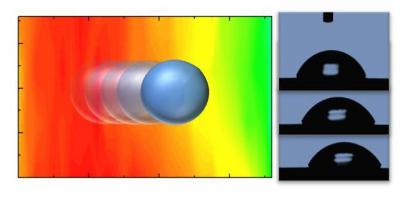Researchers from the US Naval Research Laboratory (NRL) have moved liquid droplets using long chemical gradients formed on graphene. The idea is that by changing the concentration of either fluorine or oxygen (formed using a simple plasma-based process) you can either push or pull droplets of water (also nerve agent simulant) across the surface of the graphene.

The researchers say that this could lead to applications relating to biological or chemical sensors, and also perhaps electronics and mechanical resonators. They say that in the future, such chemical gradients could be used to perhaps move single molecules.
Chemical gradients have been achieved before with large molecules (polymers) but not with graphene. The researchers used an NRL-patented plasma processing technology that can produce the necessary wafer-scale chemical patterns when combined with a physical mask.